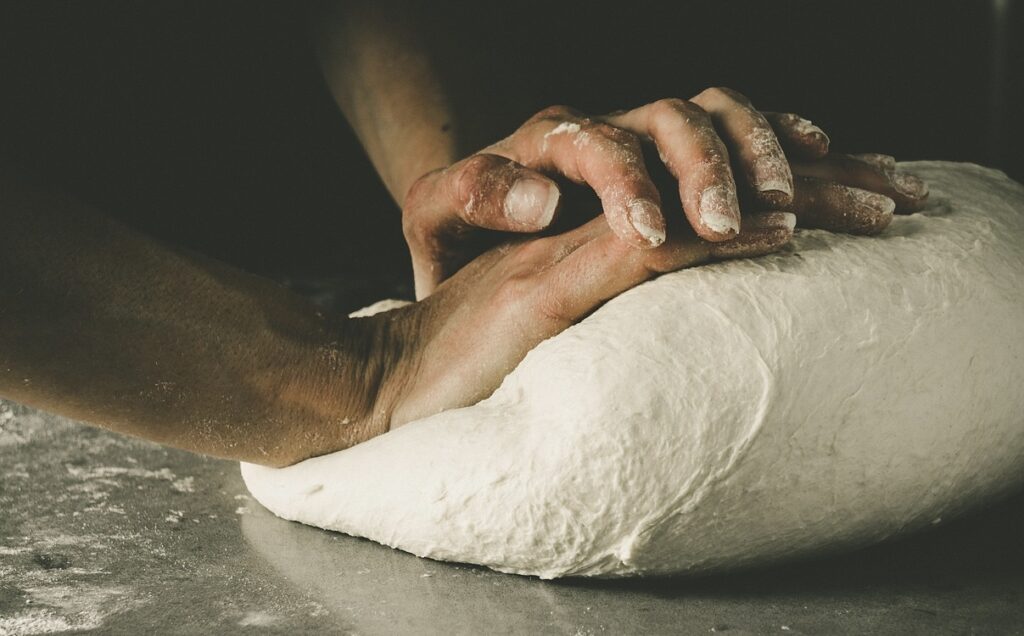It used to be a passion of mine – something akin to a cross between sex and religious fervor. When I first learned how to do it, in cooking school in New York in 1985, my bread-baking instructor called out to me, “Bonnie, I said knead the dough, not make love to it!” The whole class laughed, but that instructor was right. In that moment I’d fallen madly in love with the process of making bread.
This particular love affair lasted for decades. In all that time I never bought a loaf of bread. Instead, each week I made my own, healthy, whole-grain loaves, which became the staff of my life. This hours-long, quasi-religious rite was never a chore, it was a joy for me – the feel of the dough, the miracle of its rise, the fragrance of its baking, the taste of its goodness. All profoundly sensuous and satisfying.

(Stock photo from Pixabay)
During those decades I also taught bread-baking. In the Peace Corps in Gabon, for example, from 1996 through ’98, I invited the women in my town, Lastoursville, deep in the middle of the country’s thick rainforest, to attend free cooking lessons in my home. My bread-baking classes were always especially well attended. Here is a short excerpt from the chapter “Pain Americain” (American Bread) in my Peace Corps memoir-with-recipes, HOW TO COOK A CROCODILE:
“…The twenty-or-so Gabonese and West African women in my living room are patient with me and eager to learn. I supplement my halting French with energetic body language and lots of props (which I’d prepared ahead of time), while the women sit politely on my sprawling, L-shaped sofa and the borrowed plastic chairs I’ve arranged around the room.
“They’re wearing their Sunday-best, vibrantly colorful pagnes (wrap skirts) with matching tops and headdresses. Most have cahiers (notebooks) in their laps and are poised to take notes. Their feet, crossed at the ankles, are bare, because out of respect they removed their flip-flops and left them outside on my front porch before entering my home. …
“I scan the room and look into each woman’s eyes. They are poor by American standards but proud, overburdened by large families and little money, but quick to learn and better themselves. Looking into the faces of these eager women – Christians, Muslims, Animists, who would not otherwise gather in the same room and sit together – my heart slowly swells like the rising bread dough on the table in front of me. …”
So began my cooking classes for Pain Americain. I then painstakingly walked through the process, demonstrating every step, sometimes asking for volunteers from the audience to lend a hand:
“‘Who would like to take a turn at kneading?’ I ask the women. Arms fly up excitedly. I give each volunteer a turn. In this, there are no differences between us. We come from different worlds, we’re wrapped in different skin, but our hands are equally capable and strong. We know how to put our back into a job. Kneading bread dough comes naturally to us all. …
“With my previously made and already-risen dough, the women practice making loaves and rolls in different shapes and sizes. By now the group is animated, laughing at each other’s efforts, moving as if dancing with the dough, singing just-made-up bread songs about ‘le bon pain’ (good bread). The birds, too, outside my open windows are singing their own happy songs. The whole world, it seems to me, is happy.”
When I was a caterer in New York, as well, I always baked bread in my clients’ kitchens for their dinner parties, timing its removal from the oven to coincide with guests’ arrival, so the fresh-baked bread’s fragrance would embrace them and welcome them in to that client’s home. I publicized my style of cooking as “upscale downhome.” I wanted to give everyone at those fancy dinner tables the true taste of Home.
Due to digestive issues in recent years, I no longer eat – or make – bread. But the meaning and the mysticism of bread-baking remain exceedingly deep for me. Bread is a miracle. Bread is a symbol. Bread is universal. Bread is fundamental. Bread is life.
Today I watch the news and see thin young men carrying heavy bags of flour from dangerous distribution sites in Gaza, and I wonder what to make of this scene. I am not a poet, but my heart has just dictated these words to me to express my anguish:
Palestinian Bread
What do you do
with a sack of flour
when you have no water
no salt
no leavening —
not even a pinch of sugar
to wake the sleeping yeast —
to make your bread?
No bowl to mix the dough in
no table for kneading it
no pans to bake the loaves on
no wood for a cooking fire
no dry matches?
Your young son carried
the weighty sack
on his strong
but skeletally thin back
for many miles
and delivered it to you
proudly
in what was once
your family’s kitchen
now rubble.
You kiss his smooth cheeks
and bless him.
He is all you have now
and you ache
to bake him some bread.
~ ~ ~ ~ ~ ~ ~ ~ ~ ~ ~ ~ ~
- For more information about HOW TO COOK A CROCODILE and for the step-by-step recipe for Pain Americain (among many other recipes), go to: https://www.amazon.com/How-Cook-Crocodile-Memoir-Recipes/dp/1935925008/
- To see a short (6-minute) slide presentation of the town in the rainforest of Gabon where I lived for two years, go to: http://youtu.be/YrwQUssWGfM .
- To read about family life in Palestine before the current war there, I highly recommend award-winning author Susan Abulhawa’s brilliant novels: MORNINGS IN JENIN, THE BLUE BETWEEN SKY AND WATER, and AGAINST THE LOVELESS WORLD.
